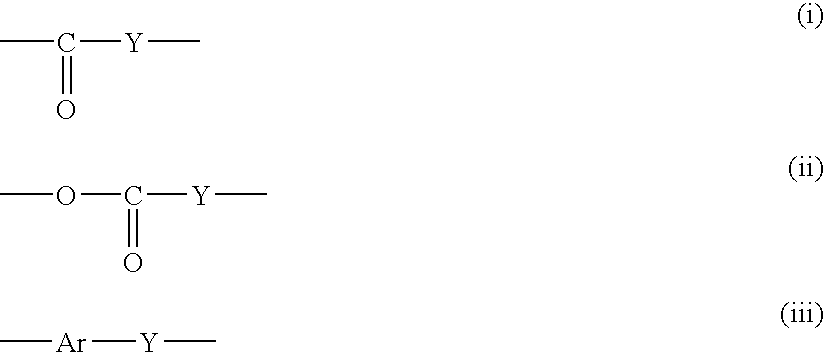Photosensitive composition
a composition and composition technology, applied in the field of photosensitive compositions, can solve the problems of insufficient solubility of the developer between an unexposed area (image area) and an exposed area (non-image area), the substrate is easily contaminated with generated heat, and the development or deficiency of development is often excessive, so as to achieve low resistance, poor flexibility, and low polarity
- Summary
- Abstract
- Description
- Claims
- Application Information
AI Technical Summary
Benefits of technology
Problems solved by technology
Method used
Image
Examples
examples
[0176]In the following, the present invention will be clarified in more details by examples thereof, but the scope of the invention is not limited by such examples. In the examples, planographic printing plate precursors employing the photosensitive compositions of the invention as image recording layers are evaluated, and the results of such evaluations were taken as those for the photosensitive compositions of the invention.
Preparation of Substrate
[0177]A JIS-A-1050 aluminum plate having a thickness of 0.3 mm was processed in combination processes of the following steps (a) to (j) to obtain substrates A, B, C and D.
(a) Mechanical Surface Roughening Process
[0178]A mechanical surface roughening was conducted with a rotating roller-shaped nylon brush, under a supply of a suspension of an abrasive (silica sand) of a specific gravity of 1.12 and water as an abrading slurry onto the surface of the aluminum plate. The abrasive had an average particle size of 8 μm and a maximum particle s...
examples 1 to 12
Comparative Examples 1 to 3
[0206]The obtained substrates A to D were coated with the following image recording layer coating solution (photosensitive composition) and were dried for 1 minute in an oven at 150° C. to obtain positive-type planographic printing plate precursors having a dry coating amount of 1.7 g / m2.
[0207]
m,p-cresol novolac (m / p ratio = 6 / 4, weight-average molecular weight(amount in Table 1)7,300, containing 0.4 mass % of unreacted cresol)vinyl polymer in Table 1(amount in Table 1)following IR absorber (cyanine dye A)0.017 gfollowing IR absorber (cyanine dye B)0.023 g2,4,6-tris(hexyloxy)benzenediazonium-2-hydroxy-4-methoxybenzo- 0.01 gphenone-5-sulfonatep-toluenesulfonic acid0.003 gcyclohexane-1,2-dicarboxylic anhydride 0.06 gVictoria pure blue BOH of which counter ion is changed to0.015 g1-naphthalene sulfonic acid anionfluorine type surfactant (Megafac F176; Dai-Nippon Ink and Chemical 0.02 gIndustries, Co. Ltd.)methyl ethyl ketone 15 g1-methoxy-2-propanol 7 gCya...
examples 13 to 15
[0220]The obtained substrate B was coated with the aforementioned undercoating solution as in the examples 1 to 12, then further coated with a lower layer coating solution of the following composition utilizing a wire bar with a wet coating amount of 28 ml / m2 to obtain a coating amount of 1.5 g / m2, and dried for 60 seconds in a drying oven at 150° C.
[0221]The obtained substrate having the lower layer was coated with an image recording layer (upper layer) coating solution of the following composition utilizing a wire bar with a wet coating amount of 11 ml / m2 to obtain a coating amount of 1.8 g / m2, and dried for 70 seconds in a drying oven at 140° C. to obtain a positive-type planographic printing plate precursor.
[0222]
N-(p-aminosulfonylphenyl)methacrylamide / methyl2.133 gmethacrylate / acrylonitrile copolymer (molar ratio 37:33:30,weight-averaged molecular weight 65,000)cyanine dye A (foregoing structure)0.098 g4,4′-bishydroxyphenylsulfone0.126 gcyclohexane dicarboxylic anhydride0.100 g...
PUM
| Property | Measurement | Unit |
|---|---|---|
| Percent by mass | aaaaa | aaaaa |
| Percent by mass | aaaaa | aaaaa |
| Pressure | aaaaa | aaaaa |
Abstract
Description
Claims
Application Information
 Login to View More
Login to View More - R&D
- Intellectual Property
- Life Sciences
- Materials
- Tech Scout
- Unparalleled Data Quality
- Higher Quality Content
- 60% Fewer Hallucinations
Browse by: Latest US Patents, China's latest patents, Technical Efficacy Thesaurus, Application Domain, Technology Topic, Popular Technical Reports.
© 2025 PatSnap. All rights reserved.Legal|Privacy policy|Modern Slavery Act Transparency Statement|Sitemap|About US| Contact US: help@patsnap.com



